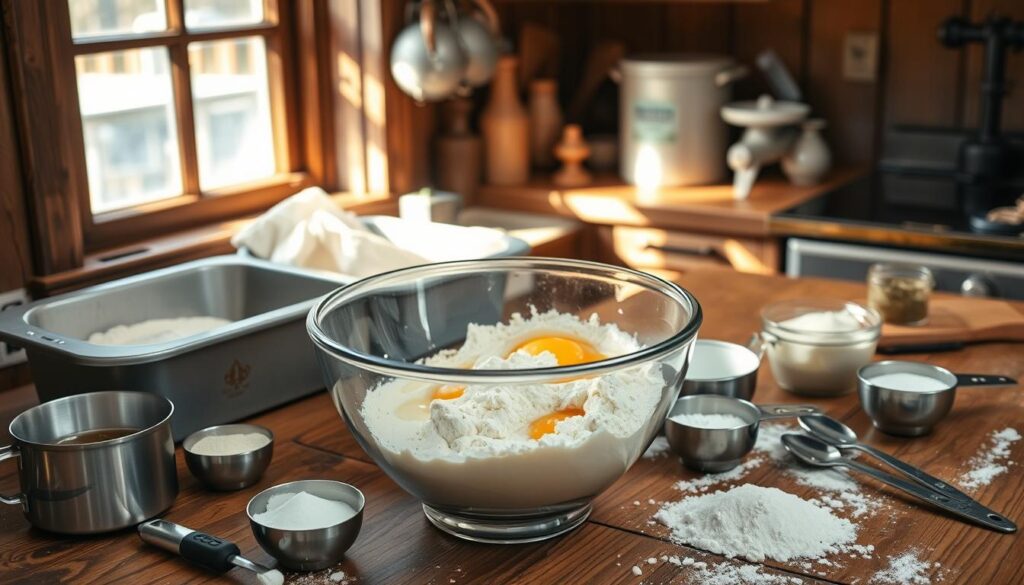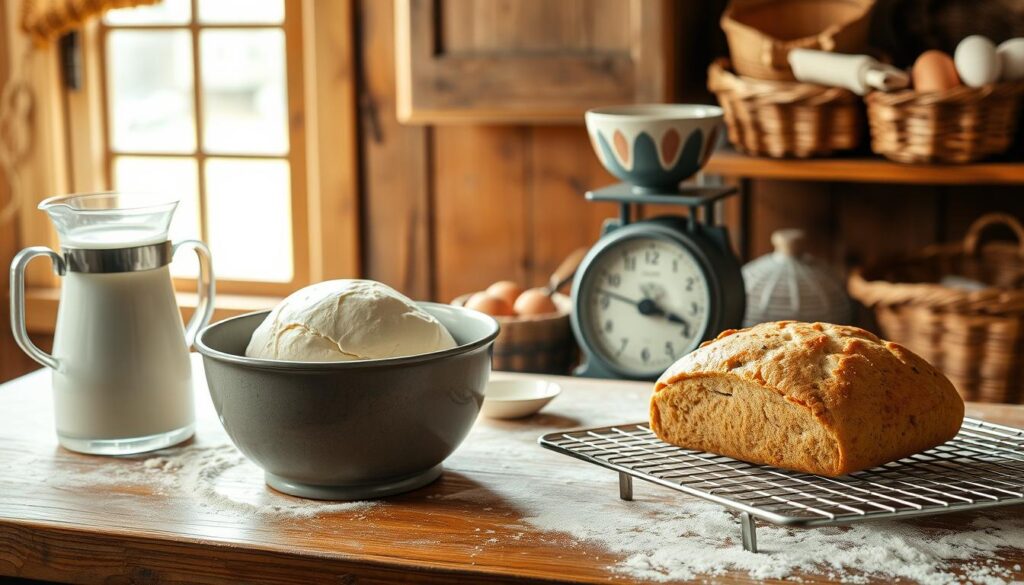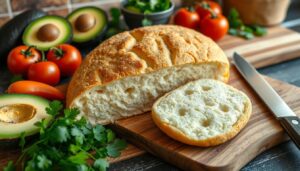The smell of fresh bread in your home brings warmth and comfort. Amish Friendship Bread is more than a recipe. It’s a tradition that connects you to others through sharing.
When you bake, you’re not just making bread. You’re building friendships and strengthening bonds. The journey starts with a special starter, passed from home to home. This tradition brings joy and togetherness, just like the Amish people did.
Table of Contents
Key Takeaways
- Amish Friendship Bread is deeply rooted in community and sharing.
- The starter is essential for creating this delicious bread and can be shared with friends.
- The entire baking process takes place over a 10-day cycle.
- This homemade bread retains its moisture and delightful flavor, making it a favorite among many.
- You can explore various flavors and uses for the starter, including muffins and additional ingredients.
- With proper care, you can freeze both the starter and baked loaves for later enjoyment.
Introduction to Amish Friendship Bread
Amish Friendship Bread is more than just a tasty treat. It’s a tradition that brings people together. For over 20 years, families and friends have shared bread, building strong bonds through kindness. This cinnamon-infused bread shows how baking can unite people, making every recipe a special experience.
To make Amish Friendship Bread, you start with a special starter. It needs careful attention for ten days to grow. Using non-metal tools is key to keep the starter fresh, ensuring each loaf is as good as the last.
The starter is a mix of flour, sugar, warm milk, and yeast. By the time you bake, you’ll have not only bread but also a way to share with others. Each batch gives you enough starter to share with friends, keeping the tradition alive and growing the baking community.

The Origins of Amish Friendship Bread
The Amish Friendship Bread has deep roots in the Amish community’s baking traditions. It’s not just a recipe; it’s a way to connect and show kindness. Friends and families share the starter, creating a sense of community and hospitality.
This tradition has been passed down for generations. It shows the importance of sharing food and building relationships. Each starter tells a story of friendship and generosity, moving from one kitchen to another.

The bread’s origins reflect a unique cultural practice that has stood the test of time. By embracing this tradition, you join a larger story. You get to share and build connections through baking.
What is a Friendship Bread Starter?
The Friendship Bread Starter is key in Amish Friendship Bread. It’s made from flour, sugar, milk, and yeast. This mix creates the leavening needed for tasty bread and adds flavor. It also symbolizes sharing kindness and love, making baking more special.
Understanding the Role of the Starter
The Friendship Bread Starter is vital for baking great bread. Without it, your bread might not taste or feel the same. Making your own starter starts a wonderful baking journey. It needs care and feeding to stay healthy.
Starters change as they interact. Sharing your starter with others makes each one unique.
How to Make Your Own Starter
Making your own starter is easy. You just need simple ingredients to start baking. Here’s how:
- Dissolve 1 packet of active dry yeast in 1 cup of warm water.
- Add 1 cup of flour and 1 cup of sugar to the mixture.
- Include 1 cup of warm milk for extra richness.
- Mix everything together and put it in a jar, like the 9-cup Bormioli Rocco Fido Square Jar with Blue Lid.
This starts your 10-day care cycle. Daily steps will keep your starter active and bubbly. It’s important to feed it right. Refrigerate or freeze it for longer storage, but be aware that long storage can change its color.
| Day | Feeding Instructions | Notes |
|---|---|---|
| 1 | Dissolve yeast in water, mix flour and sugar, add milk. | Start the cycle. |
| 2-10 | Feed regularly with the set ratios. | Look for bubbly activity; adjust if needed. |
| 10 | Prepare to share or bake with the starter. | Each starter becomes unique at this stage. |
By following these steps, you can care for your starter and enjoy delicious bread. Make your own starter and enjoy baking Amish Friendship Bread.
Amish Bread Recipe: Simple Ingredients for Sweet Delight
Making homemade Amish bread is a fun experience. It combines simplicity with great taste. This recipe is easy for anyone to make. Sharing this sweet bread with loved ones makes it all worth it.
Essential Ingredients for Your Recipe
- 1 ¼ ounce package active dry yeast (2¼ teaspoons)
- ¼ teaspoon granulated sugar
- ½ cup warm water (105-110° F)
- 1 cup Amish Friendship Bread starter
- ½ cup warm milk (105-110° F)
- 1 tablespoon kosher salt
- 3 tablespoons vegetable oil
- 2¾ to 3¼ cups bread flour
- Optional: nuts, raisins for texture and flavor
Preparation Steps for Homemade Amish Bread
Get ready to wow with this simple recipe. Start by mixing yeast, warm water, and sugar. Let it sit until it’s frothy. Then, mix the starter, milk, salt, and oil in a big bowl.
Add the yeast mixture and stir well. Sift in the flour and mix until it’s soft. Your dough is now ready.
Put the dough in a greased bowl, cover it, and let it rise for an hour. It should double in size. Punch it down and divide it into two parts. Put each part in a greased loaf pan dusted with cinnamon-sugar.
Bake at 325°F for about an hour. You’ll get 16 slices of sweet homemade Amish bread. It’s perfect for any time.
The 10-Day Cycle for Maintaining Your Starter
Keeping your Amish Friendship Bread starter alive is easy with a 10-day cycle. Each day, you’ll do simple tasks to keep it healthy. These Amish Friendship Bread instructions will help you have a strong starter for baking.
Day-by-Day Instructions for Care
During this cycle, you’ll mostly mix and feed your starter. Here’s what to do:
- Days 1-5: Mash the bag every day to mix the ingredients. This makes the mixture airy.
- Day 6: Feed your starter with 1 cup each of flour, sugar, and milk. Look for bubbles within 4-24 hours after feeding.
- Days 7-9: Keep mashing the bag daily. Watch for bubbles to see if your starter is active.
- Day 10: It’s time to split the starter. You’ll have enough for a loaf and to share. Make sure to keep 1-3 cups for later use.
Use a container that’s almost 68 ounces to give your starter room to bubble. Keep it at 1 to 3 cups for best results. Regular feeding is key; neglecting it can kill your starter. This cycle keeps your starter healthy and ready to make great bread for years.
Amish Friendship Bread Variations to Try
Amish Friendship Bread is more than just a tasty treat. It’s a canvas for creativity, with endless possibilities. Bakers love to try new things, making each batch special. This way, you can make the bread just how you like it, whether it’s for a treat or a special occasion.
Exploring Different Flavor Combinations
Adding different flavors can make baking exciting. Some favorites include:
- Chocolate chips
- Dried fruits like cranberries or apricots
- Spices such as nutmeg or cardamom
- Nuts for added crunch
These additions can make your bread even more delicious. You can choose flavors that match the season or your mood. It’s a fun way to share your love of baking with others.
Using Alternate Ingredients for Healthier Options
Want to make your bread healthier? Try these swaps:
- Replace oil with applesauce to reduce fat content
- Use whole wheat flour instead of all-purpose flour for added nutrition
- Incorporate natural sweeteners like honey or maple syrup instead of granulated sugar
These changes let you enjoy Amish Friendship Bread without feeling guilty. You’ll find that they keep the bread tasty and satisfying. Plus, they’re good for you too.
Sharing the Gift of Amish Friendship Bread
Sharing Amish Friendship Bread is a way to show love and connection in our communities. When you bake and share, you bring people closer. Each loaf is more than food; it’s a symbol of friendship and connection.
Try making Lemon Cranberry Amish Friendship Bread for a special touch. It’s easy to make with simple ingredients like 1 cup of oil and 1 cup of sugar. Bake it at 325 degrees Fahrenheit for 45 to 60 minutes. Then, share it with family or friends, spreading joy and warmth.
Sharing your bread brings joy and creates lasting memories. Every bite is a taste of love and care. Your baking can make your community a warmer and kinder place.
Make sharing bread a regular tradition. It’s a way to deepen your connections and bring happiness to others. Seeing the smiles on their faces is as rewarding as baking itself.
Tips for Successful Baking
Baking can be a fun experience, especially when you make something special like Amish Friendship Bread. To get the best results, knowing some baking tips and common mistakes is key. This section will help you avoid mistakes and keep your baked goods tasty and soft.
Common Mistakes to Avoid
Knowing and fixing common baking mistakes can make your baking better. Here are some mistakes to watch out for:
- Inaccurate measurements: Always measure your ingredients carefully. A small mistake in measurements can change how your bread turns out.
- Skipping rest time: Letting your dough rest is important for its texture and taste.
- Avoiding metal utensils: Use wooden or silicone tools with your starter to avoid bad chemical reactions.
Storing and Preserving Your Bread
Storing your bread right keeps it fresh longer. Here are some tips to keep your bread tasty and soft:
- Keep your bread in an airtight container to stop it from getting stale.
- If you can’t eat it in a few days, freeze it. Freezing keeps it fresh.
| Tip | Description |
|---|---|
| Accurate Measurements | Use a kitchen scale for precise ingredient quantities. |
| Rest Time | Allow dough to rise as specified for optimal texture. |
| Utensil Choice | Choose silicone or wooden utensils when working with starters. |
| Airtight Storage | Utilize containers that seal tightly to keep bread fresh. |
| Freezing | Wrap bread well in plastic wrap before freezing to maintain quality. |
The Social Impact of Baking and Sharing
Baking does more than just fill your kitchen with a lovely smell. It helps build connections in your community, especially with recipes like Amish Friendship Bread. Sharing a homemade loaf with friends or neighbors is more than a gift. It’s a chance to grow closer together.
Working together to make a meal can spark deep conversations. The joy of baking together creates a space for laughter and stories. It’s a way to share your family’s history and traditions, making your bonds stronger.
Baking also brings people together in a supportive way. It makes everyone feel valued and appreciated. By sharing recipes and baking together, we exchange ideas and creativity, making our food culture richer.
The table below shows some of the good things that come from baking and sharing:
| Aspect | Description |
|---|---|
| Bonding Opportunities | Brings individuals together, fostering relationships through shared cooking experiences. |
| Community Support | Creates a network of encouragement among neighbors and friends during gatherings. |
| Cultural Exchange | Promotes sharing recipes that reflect personal heritage and diverse culinary traditions. |
| Emotional Connections | Strengthens emotional ties by evoking nostalgia and collective memories through shared meals. |
Amish Friendship Bread: A Sweet Tradition to Pass On
Sharing a treasured recipe strengthens bonds beyond the kitchen. Amish Friendship Bread is a perfect example. It lets you share a sweet tradition that enriches your community. Each starter you give away connects friends and family, inviting them to join in a delightful process.
The Importance of Community in Baking
By baking, you join a family that values kindness and sharing. Giving a starter shows your commitment to building relationships. It’s a tradition that brings joy to generations, symbolizing love and warmth.
Think of the smiles when friends get a starter bag. They know they’ll soon bake and create memories. This sweet tradition is about building a community that loves baking.
Conclusion
Amish Friendship Bread is more than a recipe. It’s a way to share sweetness and build connections. When you make this bread, you create a special moment in your kitchen.
This bread’s magic comes from its shared roots. Passing on the starter strengthens our bonds through cooking. Enjoying it fresh or freezing it for later, it reminds us of happy times with friends.
Every batch of Amish Friendship Bread has its own story. It’s not just about the bread, but the people it brings together. Let’s keep baking and sharing this tradition with our communities.
F.A.Q
-
What is Amish Friendship Bread?
Amish Friendship Bread is a sweet, cinnamon-infused bread. It comes from the Amish culture. It’s made with a special starter that’s passed among friends, creating a cycle of baking.
-
How do I make a Friendship Bread starter?
To make a starter, you need yeast, warm water, flour, sugar, and warm milk. First, dissolve the yeast in water. Then, mix it with flour and sugar. Finally, add milk. This starts a 10-day cycle for your starter.
-
What ingredients are needed for the Amish Friendship Bread recipe?
You’ll need starter, eggs, oil, milk, sugar, and flour for the classic recipe. Adding nuts or raisins can also enhance the flavor and texture
-
How do I maintain my Friendship Bread starter?
Keeping your starter involves a 10-day cycle. Each day, mix the starter. On Day 6, feed it with more ingredients. On Day 10, divide it for sharing and baking.
-
Can I experiment with different flavors in my Friendship Bread?
Yes! Many bakers like to try new flavors. You can add chocolate chips, dried fruits, or spices to make unique versions of the traditional bread.
-
How can I make my Amish Friendship Bread healthier?
To make it healthier, substitute oil with applesauce or use whole wheat flour. These changes suit different diets while keeping the bread’s traditional taste.
-
What are some common mistakes to avoid when baking Amish Friendship Bread?
Avoid mistakes like wrong ingredient amounts, skipping rest times, and using metal with the starter. These can ruin your bread’s quality.
-
How should I store my freshly baked Amish Friendship Bread?
Store your bread in an airtight container or freeze it. This keeps it fresh and preserves its taste and texture for longer.
-
What is the significance of sharing Amish Friendship Bread?
Sharing the bread is key to the tradition. It builds connections, strengthens bonds, and shows appreciation. Every loaf is a heartfelt gift that represents community.



